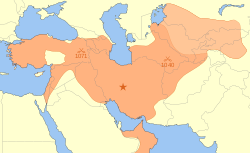Saljuq Empire
| Seljuk Empire | |||||
| آلِ سلجوق Āl-e Saljuq |
|||||
|
|||||
|
Seljuq Empire at its greatest extent in 1092,
upon the death of Malik Shah I |
|||||
| Capital |
Nishapur (1037–1043) Rey (1043–1051) Isfahan (1051–1118) Hamadan, Western capital (1118–1194) Merv, Eastern capital (1118–1153) |
||||
| Languages |
|
||||
| Religion | Sunni Islam (Hanafi) | ||||
| Government | Monarchy | ||||
| Sultan | |||||
| • | 1037–1063 | Toghrul I (first) | |||
| • | 1174–1194 | Toghrul III (last) | |||
| History | |||||
| • | Tughril formed the state system | 1037 | |||
| • | Battle of Dandanaqan | 1040 | |||
| • | Battle of Manzikert | 1071 | |||
| • | First Crusade | 1095–1099 | |||
| • | Battle of Qatwan | 1141 | |||
| • | Replaced by the Khwarezmian Empire | 1194 | |||
| Area | |||||
| • | 1080 est. | 3,900,000 km2 (1,500,000 sq mi) | |||
in Anatolia
Artuqid dynasty
Saltuqid dynasty
in Azerbaijan
Ahmadili dynasty
Ildenizid dynasty
in Egypt
Tulunid dynasty
Ikhshidid dynasty
in Fars
Salghurid dynasty
in The Levant
Burid dynasty
Zengid dynasty
in Yemen
Rasulid dynasty
The Seljuk Empire or Great Seljuk Empire (also spelled Seljuq) (Persian: آل سلجوق) was a medieval Turko-PersianSunni Muslim empire, originating from the Qynyq branch of Oghuz Turks. The Seljuk Empire controlled a vast area stretching from the Hindu Kush to western Anatolia and from Central Asia to the Persian Gulf. From their homelands near the Aral Sea, the Seljuks advanced first into Khorasan and then into mainland Persia before eventually conquering eastern Anatolia.
The Seljuk empire was founded by Tughril Beg (1016–63) in 1037. Tughril was raised by his grandfather, Seljuk-Beg, who was in a high position in the Oghuz Yabgu State. Seljuk gave his name to both the Seljuk empire and the Seljuk dynasty. The Seljuks united the fractured political scene of the eastern Islamic world and played a key role in the first and second crusades. Highly Persianized in culture and language, the Seljuks also played an important role in the development of the Turko-Persian tradition, even exporting Persian culture to Anatolia. The settlement of Turkic tribes in the northwestern peripheral parts of the empire, for the strategic military purpose of fending off invasions from neighboring states, led to the progressive Turkicization of those areas.
...
Wikipedia

